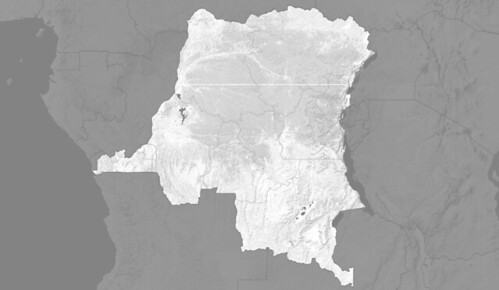Palm Oil Boom?
Photo: Illegal forest clearance in Tesso Nilo National Park, Indonesia (Bottrill/Moabi)
Oil palm cultivation has expanded tremendously around the world. Indonesia and Malaysia are the epicenter of this development. In these two countries, new plantations have led to 3.7 million hectares of forest loss of during the last 20 years. Demand for palm oil remains high and there is now evidence that the palm oil boom might spill over to Africa. In fact, the first oil palm plantations were planted 100 years ago in Democratic Republic of the Congo (DRC). In 1958, 147 thousands hectares of oil palm plantations were established in the DRC, but several decades of political unrest and mismanagement led to the abandonment of most of the plantations. Now things are changing: in 2009, 100,000 hectares of plantations have been acquired for rehabilitation and a number of companies have shown interest to invest in the palm oil sector in DRC. In order to better identify potential trade-offs between further oil palm plantation expansion, forest conservation, and land use planning in DRC, we have assessed the biophysical suitability of palm oil.
What are the optimal growing conditions for palm oil?
Photo: Oil palm plantation, Cameroon (Bottrill/Moabi)
Oil palm grows in warm and wet conditions. Temperature should range between 24-28°C and the average temperature of the coldest month of the year should not fall under 15°C. This limits oil palm production to the tropical and sub-tropical area. Oil palm requires both substantial and regular rainfall: 2000-2500 mm rainfall per year with a minimum of 100 mm per month is ideal. Optimal soil conditions for oil palm are fine structured soils with high clay content, or loam and silt dominated soils. However, a wide range of tropical soils are suitable including some that could not be used to grow other crops. Many soil constraints could also be overcome with proper management . Finally, flat areas are better because weak anchorage of the plants, fertilizer runoff, and topsoil erosion are problematic on steep slopes.
The figure above shows how we developed the suitability map by combining spatially explicit bio-physical data and agronomic information at the resolution of 1km using a geographic information system (GIS) (blue rectangles= spatial data; green rectangles = a-spatial information and the computation procedure)
Where are the most suitable areas to grow palm oil in DRC?
Photo: Mountainous terrain in eastern DRC (Bottrill/Moabi) Huge tracts of land are potentially suitable in DRC: we estimate that oil palm could be grown on three quarters of DRC territory. However, only 30% of this area is highly suitable. The rainfall pattern creates the most favorable conditions along the Congo River in the Equateur and in the northeast of Orientale province. The south of the country is not suitable due to the longer dry season and the lower temperature during certain months, while the eastern part of the country is excluded due to the mountains.
Changes in rainfall patterns when one goes further north and thick layers of sand in the southwest and central part explain lower suitability.
DRC is the second most suitable palm oil country after Brazil
Photo: Oil palm plantation, Cameroon (Bottrill/Moabi) Overall, 50% of the total suitable area is located in the rainforest, including the highly suitable area. Much of this area also covers large blocks of intact forest, which are home DRC’s rich biodiversity and many indigenous groups. Large suitable areas can also be found on existing cropland, rural complex, and mosaic forest-savannah but usually with a lower suitability. DRC ranks second behind Brazil in terms of total potential suitable land for oil palm but because of lower and more irregular rainfall, the share of highly suitable area is lower than to Southeast Asian countries and the Amazon basin.
Biophysical suitability is not all
Photo: Okapi in captivity (Miller/http://commons.wikimedia.org/wiki/File:Okapia_johnstoni) Beyond biophysical suitability, many other factors will determine whether DRC’s natural forests are cleared for plantations. Conservation measures such as protected area system can stop conversion of biodiversity rich areas but will require strong park management and enforcement. Reserves such as the Okapi Faunal Reserve, Rubi-Tele Hunting Zone, and Yangambi Biosphere Reserve all fall within areas of high suitability reserve and could be threatened by expanding palm oil plantations.
The presence of logging companies can further drive palm oil expansion. The conversion of primary forest to oil palm plantations is often financed by the immediate benefits from timber sales. Furthermore, there are around 38 logging concessions currently in the high suitability zone.
At least two REDD+ projects also fall within the high suitability area for REDD+, and there are currently no regulations preventing palm expansion into these project areas. Isangi and Jadora are also bordered by abandoned palm oil plantations, which the DRC government plans to reactivate.
Palm oil expansion will also be determined by accessibility to refinery plants and markets - a key determinant for oil palm plantation profitability. Labor availability, productivity, and cost will also constrain expansion in the Congo Basin, and the institutional environment in DRC - characterized by high corruption and a weak justice system - could make investments risky. And finally expansion into the country’s hinterlands will be slowed by poor transport infrastructure. In 2005, DRC had only around 2,000km of paved road in the entire country. To put this into perspective, Austria has 100 times more paved road than DRC but is only 4% its size. For more information:http://rdc.moabi.org/will-drc-palm-oil-plantations-cause-forest-loss/en
Featured Map Layers
Click on a layer to add it to the map
- Indigenous Lands
- Logging Concessions
- Agriculture Concessions
- Road Rehabilitation Projects
- REDD+ Projects
- Protected Forest Areas
- UMD Forest Cover (2000)
- Palm Oil Suitability
